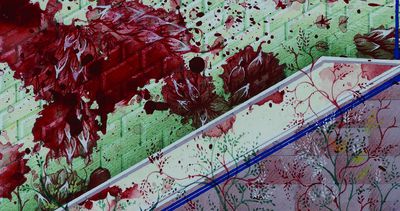The Seminal Art of Aisha Khalid

Formally trained in the Indo-Persian miniature traditions from the National College of Arts Lahore and having completed her post-graduation from the Rijksakademie in Amsterdam, Aisha Khalid is one of Pakistan’s most acclaimed artists. One of the leading exponents of the Neo-miniature, her contribution to Pakistani art is huge. Her work is important for South Asian and world audiences because it questions western ideals encouraging audiences to look at events through an eastern lens.
.jpg)
Khalid’s artistic vocabulary draws heavily from her childhood experiences. Born in Faisalabad, she spent her formative years in Shikarpur-Sindh, where the floor tiles of her home became the inspiration for the geometric patterns that can be seen in many of her works. These shapes appear regularly in her work in evolved forms.
Khalid’s inceptive works were a reflection of very personal stories, challenges and tribulations, addressing gender issues as a result of entrenched socio-cultural anomalies curbing women.
Having experienced the backlash from 911 firsthand while studying in Amsterdam, her art practice turned from personal topics to political concerns very early on in her career. Khalid’s response to Botticelli’s birth of Venus through her own series with the same title challenges Western standards, providing an insight into the systemic objectification of women. In her work instead of a shell, Venus is positioned inside a lotus flower, symbolic of purity and divinity in South Asian cultures. Standing as if making her debut on stage with curtains drawn, Khalid’s Venus appears to be coming out of an enclosed room or a chardiwari, unabashedly covered in a burqa.
Through her intricately rendered works she encourages audiences to appreciate Eastern points of view and understand world events through a non-western lens. Although this is evident in many of her works I am just going to elucidate a few examples.
For her site specific installation at the Queens Palace, Bagh-e-Babar in Kabul, 2008 titled ‘Viewpoint’ she positioned her work in front of an open window. Painting an intricately patterned red vortex resembling a pool of blood on the floor she extended a linear pattern from the vortex to the window to include the bullet riddled buildings outside the gallery space into her work On the wall next to the window she placed small vortices resembling gun shots. Through this seminal piece Khalid managed to bring the dimensions of space and time into her work and in the process encouraging viewers to understand and empathise with the history of the region.

Asked to replicate the same work for the Venice Biennale in 2009, she chose to modify the artwork, taking the audience and venue into consideration. Naming the installation Viewpoint, she painted intricately patterned vortices resembling gunshots onto large mirrors. These vortices were projected onto the bodies of the viewers, prompting them to understand world events through Eastern perspectives. What is even more interesting is that each shape is enclosed with curved folds resembling the hemlines of Afghan burqa, bringing into play the ravages of war from the female perspective.
Through her installation for the Moscow biennale in 2013 Khalid steered the focus towards the adverse effects of the Industrial revolution on the weavers of Bengal. Employing a long stretch of white muslin stamped with rose motifs she recreated the scene of an energetic setting abandoned midway, by leaving some roses half-done amid the few fully embroidered ones. A parallel length of camouflage printed fabric stretched alongside, hinting at war and unrest. Cleverly drawing on and turning around key words from a quote by Tolstoy ‘The two most powerful warriors are patience and time’ she titled the work Time and Patience to point to that particular era and the helplessness of the weavers at that point, encouraging western viewers to understand Eastern viewpoints.
Her 2021 retrospective in Karachi entitled ‘I Am And I Am Not’ is intended as a comprehensive exhibition of her works dating from 1993 to the present. The main venue for the show the ‘Frere Hall’ originally built as a town hall is an imposing 19th century colonial edifice built in Venetian Gothic style. During the British Raj natives of lower rank were discouraged from entering the premises. This context makes for an interesting dialogue between work that addresses dichotomies between east and west and questions Western ideals.
The theme ‘I Am and I Am Not’ will manifest itself via its spatiotemporality. Being placed in the once elite town hall turned public venue each work will be situated in conversation with others, as well as its surroundings. The evident disparities between East and West addressed in Khalid’s work will be put into perspective by the wider colonial context of Frere Hall encouraging diverse and varied interpretations.
Khalid has participated in many solo and group exhibitions nationally and internationally, including the Fukuoka Triennale 2001, Bagh-e-Babur Kabul 2008, the Venice Biennial 2009, Sharjah Biennial 2011, Moscow Biennial 2013, and in London the Victoria & Albert Museum, the Corvi-Mora Gallery, Asia House, Whitworth Art Gallery Manchester, Aga Khan Museum Toronto, The Royal Academy, and Modern Art Museum Arnhem, The Netherlands. Khalid has been a finalist and people’s choice winner of the Jameel Prize 2011, and has also been awarded the ‘Alice Award 2012’, and the ‘Birgit Skiold Memorial Trust Award of Excellence 2010’. Her work is part of several museum and private collections all over the world, such as the king Abdul Aziz center for world culture, Ithra, Saudi Arabia, the Aga Khan Museum Toronto, M+ Museum Hong Kong and the Victoria & Albert Museum, London.
Masuma Halai Khwaja is an artist, art educator and curator based in Karachi Pakistan.
Similar content
posted on
posted on
posted on
posted on
posted on
posted on




